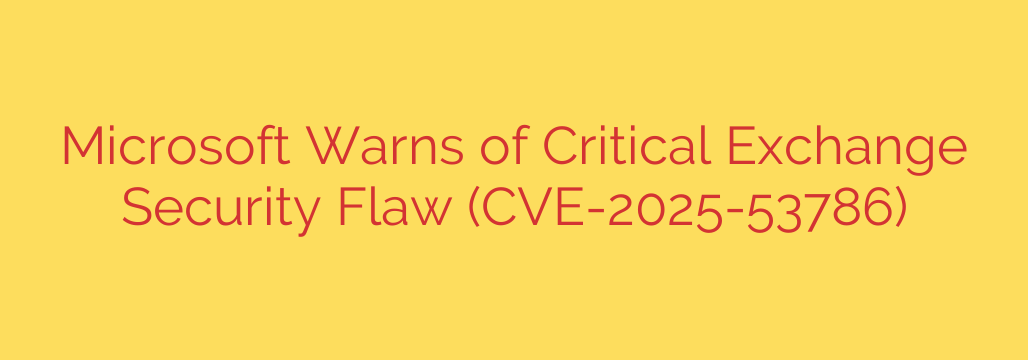
Urgent Security Alert: Patch Your Microsoft Exchange Server Immediately
A critical vulnerability has been discovered in on-premises versions of Microsoft Exchange Server, posing a significant security risk to organizations that have not yet applied the latest updates. This flaw, tracked as CVE-2025-53786, could allow an unauthenticated attacker to achieve remote code execution (RCE) on a vulnerable server, potentially leading to a complete system compromise.
If your organization uses a self-hosted Microsoft Exchange Server, immediate action is required to protect your sensitive data and network integrity.
Understanding the Threat: What is CVE-2025-53786?
This newly identified vulnerability is considered critical because it can be exploited remotely by an attacker without needing any valid login credentials. In simple terms, a malicious actor from anywhere on the internet could target a vulnerable Exchange server and execute their own code.
This type of flaw is particularly dangerous because it bypasses standard authentication defenses. An attacker who successfully exploits this vulnerability could gain a foothold equivalent to a system administrator, enabling them to:
- Steal sensitive data, including emails, attachments, and address books.
- Deploy ransomware across your network, encrypting critical files and demanding payment.
- Install persistent backdoors for long-term espionage and data theft.
- Use your server as a launchpad for further attacks against other systems within your organization’s network.
The ability for an unauthenticated attacker to achieve a complete server takeover makes this one of the most severe types of security flaws.
Are You Affected?
This vulnerability impacts self-hosted (on-premises) Microsoft Exchange Servers. The specific versions confirmed to be at risk are:
- Microsoft Exchange Server 2019
- Microsoft Exchange Server 2016
While older versions like Exchange 2013 are no longer supported, they are likely also vulnerable and should be considered compromised if exposed to the internet.
Crucially, customers using Microsoft Exchange Online (part of the Microsoft 365 suite) are not affected by this specific vulnerability. Your service is managed and patched directly by Microsoft.
Action Required: How to Secure Your Exchange Server Now
Time is of the essence. Active exploitation of such critical vulnerabilities often begins within hours or days of their public disclosure. Follow these steps immediately.
1. Apply the Security Patch
The single most important step is to install the latest security updates released by Microsoft. These patches are designed to close the security hole and prevent exploitation. Prioritize the installation of these updates on all of your Exchange Servers, especially those that are accessible from the internet (e.g., via Outlook Web App).
2. Verify the Patch Installation
After applying the updates, it is essential to verify that the installation was successful and the patch is active. Follow Microsoft’s post-installation guidance to ensure your servers are fully protected and no longer vulnerable.
3. Hunt for Signs of Compromise
Because this vulnerability may have been known to attackers before it was publicly disclosed, you must check for signs of a breach. Proactively investigate your servers for any unusual activity, including:
- Unexplained processes or services running on the server.
- Suspicious network connections originating from the Exchange server.
- Unexpected new files, especially in web-accessible directories.
- Unusual account activity or newly created user accounts.
If you suspect a compromise, activate your incident response plan and consider taking the affected server offline for forensic analysis.
Mitigation Steps If You Cannot Patch Immediately
While patching is the only true solution, if you are unable to do so right away, you should implement temporary mitigation measures to reduce your risk. These are not a replacement for patching but can provide a layer of defense.
- Restrict Access: Limit all external access to your Exchange Server at the network firewall. If possible, block all connections to it until you can apply the patch.
- Enable a Web Application Firewall (WAF): A properly configured WAF may be able to block the malicious requests used to exploit this vulnerability.
- Enhance Monitoring: Increase the level of logging and monitoring on your Exchange Servers and surrounding network devices to detect and alert on any suspicious activity immediately.
Protecting your organization from evolving threats requires constant vigilance. Taking swift and decisive action on critical vulnerabilities like this is not just a best practice—it’s an essential part of modern cybersecurity.
Source: https://www.helpnetsecurity.com/2025/08/07/exchange-hybrid-deployment-vulnerability-cve-2025-53786/








